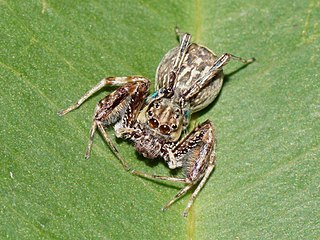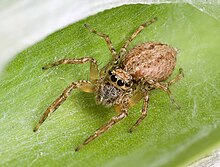
Wolf spiders are members of the family Lycosidae. They are robust and agile hunters with excellent eyesight. They live mostly in solitude, hunt alone, and usually do not spin webs. Some are opportunistic hunters, pouncing upon prey as they find it or chasing it over short distances; others wait for passing prey in or near the mouth of a burrow.
Artabrus is a genus of jumping spiders with only two species. The type species, Artabrus erythrocephalus, was described in 1846 by C. L. Koch as Plexippus erythrocephalus and transferred to his new genus Artabrus by Eugène Simon in 1902. It remained the only species in the genus until a second species was described in 2020.

Ascyltus are a genus of jumping spiders in the family Salticidae that was first described by Ferdinand Anton Franz Karsch in 1878. As of December 2020, the genus contained 10 species. Ascyltus spiders utilize their vision in courtship, hunting, and navigation. They are typically large to medium-sized salticids and often move relatively slowly. However, they are capable of agile jumps when moving, hunting, or to avoid predators. They have well developed book lungs and tracheal systems, and they are capable of utilizing both systems. Ascyltus have four pairs of eyes, with the anterior median pair being the most prominent. One distinguishable characteristic of the genus is their antero-lateral carapace, which is iridescently coloured.

Brettus is a genus of jumping spiders. Its six described species are found in southern Asia from India to China and Sulawesi, with a single species endemic to Madagascar.

Cosmophasis is a genus of spiders in the family Salticidae. They are predominantly Southeast Asian, while some species occur in Africa and Australia. Although most species more or less mimic ants, there are also colorful species that follow a different strategy.

Cytaea is a genus of spiders in the family Salticidae.
Eburneana is a genus of the spider family Salticidae.
Ergane is a genus of jumping spiders that was first described by Ludwig Carl Christian Koch in 1881. Males of E. benjarei is 9 millimetres (0.35 in) long. The form of the pedipalp and the abdominal pattern suggest that Ergane is close to Chalcotropis. It is named after the goddess Athena, called Athena Ergane as the patron of craftsmen and artisans.

Hinewaia is a genus of the jumping spiders found in New Zealand. Its single described species is Hinewaia embolica.
Paraphilaeus is a genus of the jumping spiders found in Queensland and New South Wales. It contains only one species, Paraphilaeus daemeli. Though it has been known for a long time, in 2003, closer investigation showed that it represents a new genus and is neither related to Plexippus nor Trite. The genus name is derived from Ancient Greek para "alongside" and the salticid genus Philaeus.

Udvardya is a genus of jumping spider endemic to New Guinea. As of 2017, it contains only one species, Udvardya elegans.

Saitis barbipes is a common jumping spider found in the Mediterranean region.
Metaphidippus pernix is a species of spider in the Salticidae family found in Guatemala.
Heliophanus bisulcus is a jumping spider species in the genus Heliophanus. It was first described by Wanda Wesołowska in 1986 and is found in Namibia and South Africa. What had been designated the species Heliophanus villosus was recognised as the female of this species in 2003.
Heliophanus demonstrativus is a jumping spider species in the genus Heliophanus. Found in East and Southern Africa, the species was first described by Wanda Wesołowska in 1986.
Heliophanus falcatus is a jumping spider species in the genus Heliophanus. It was first described by Wanda Wesołowska in 1986 and is found in Angola and the Democratic Republic of the Congo. The female of the species was thought to be a separate species Natta immemorata until 2003.
Heliophanus innominatus is a jumping spider species in the genus Heliophanus. It was first described by Wanda Wesołowska in 1986 and lives in Madagascar.
Rhene formosa is a species of jumping spider in the genus Rhene that lives in the mountains of Guinea. The female was first identified in 2002 while the male remains unknown. The spider is small, with a line of white hairs on a darker brown carapace and a lighter beige and longer elongated abdomen.

Heliophanillus fulgens is a jumping spider species in the genus Heliophanillus that can be found in a large distribution that extends from Greece to Central Asia. The species, which was first described in 1872, was originally named Salticus fulgens, but was later placed successively in the genera Euophrys and Icius before the current name was agreed in 1989. The spider is small, ranging in body length between 2.25 and 3.3 millimetres, the female being larger than the male. It is rusty brown with white hairs and primarily lives around the Eastern Mediterranean from Greece into North Africa and Asia.
Neaetha catula is a species of jumping spider in the genus Neaetha that lives in East and Southern Africa. The male was first described in 1886 by Eugène Simon and the female by Ludovico di Caporiacco in 1949. First discovered in Zanzibar, examples have also been identified in Kenya. The spider is small, 3 mm (0.12 in) long, with a generally black cephalothorax and abdomen, although the abdomen has a pattern of spots towards the rear and a thin line that divides it in two. The species can be distinguished from others in the genus by the lack of central pocket in the female's epigyne. This feature led Dmitri Logunov to consider whether the spider belongs to the genus.









